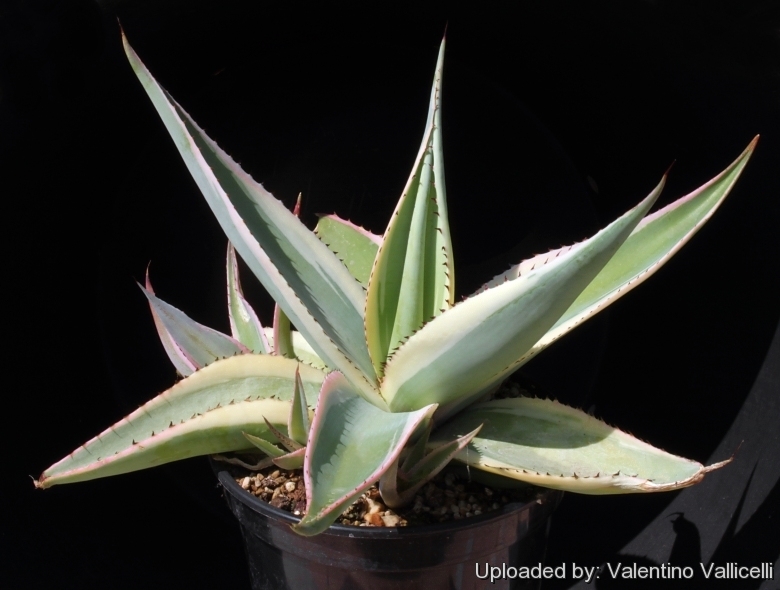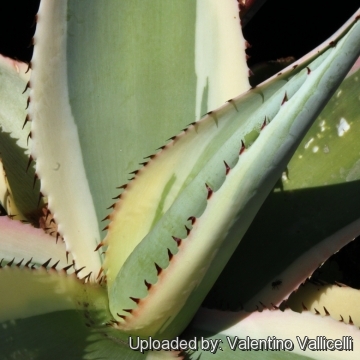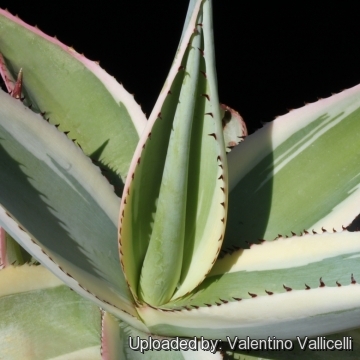
Agave guiengola cv. Cream Brulee Photo by: Valentino Vallicelli
Origin and Habitat: Garden origin (Nursery produced cultivar)
Synonyms:
See all synonyms of Agave guiengola
back
Accepted name in llifle Database:Agave guiengola GentryBrittonia 12: 98 1960
Cultivars
(1):
back
Common Names include:
ENGLISH: Creme Brulee Century Plant, Creme Brulee Century Plant
Description: Agave guiengola is a fairly fast growing agave with few soft succulent leaves. It’s uniquely shaped, silvery-bluish leaves makes it a very unique statement in the landscape and it is considered by some collectors to be the most spectacular large agave because of its sculptural form. Plants in habitat are mostly single while the more common cultivated clones sucker profusely.
Rosettes: 90-120 cm. tall by 120-180 cm. acaulescent, with few spreading open leaves ( ca. 25 to 30 leaves at maturity) that lay more horizontally than most Agaves.
Leaves: Thick, ghostly-pale, glaucous, very broad at the base ovate to ovate lanceolate and taper to brown terminal spines. Nearly plane above and narrowly channelled apically. Along the edge of the 30-55 cm long leaves there are few to many dark-colored variously serrated teeth (this is a variable trait) The teeth alternate in size between small and large ones along the leaf margins. There is also some variation in leaf size and colour.
Inflorescence: When mature this plant produces a 150-200 cm spike flowering from near the base.
Flowers: Yellow inconspicuous, 33-35 mm long, almost tubeless with distinct tepals and the insertion of the filaments at the base. The flowers attract hummingbirds.
Blooming season: Spring to summer. Typically it flower only at maturitv once every 15-25 years and the main crown dies after blooming.
Fruit: Capsules 22-24 mm long, oblong, thin walled.
Variegated form: The very attractive variegated type, formerly sold in the trade under the name Agave guiengola 'Marginata', was discovered by California agave specialist, Kelly Griffin. Since the name “Marginata” has been invalid on plants named after 1959 it has been chosen the cultivar name “Creme Brulee”. This form has bluish-green leaves surrounded by a 1-2,5 cm border of creamy white to butter cream yellow that takes a nice pink hue under cold and sunny conditions. Tiny but sharp, dark brown spines line the leaf margins, culminating in a longer terminal spine. ‘Cream Brulee' produces variegated offsets with very narrow leaves. This variant makes an exceptionally beautiful, if somewhat formal, landscape statement. The variegated form is about 25 percent smaller than the normal one.
Subspecies, varieties, forms and cultivars of plants belonging to the Agave guiengola group
 Agave guiengola Gentry: It is recognizable for its wide open rosette of bluish-green, thick, soft, boat-shaped leaves that lay more flat than upright.
Agave guiengola Gentry: It is recognizable for its wide open rosette of bluish-green, thick, soft, boat-shaped leaves that lay more flat than upright. Agave guiengola cv. Cream Brulee: has bluish-green leaves surrounded by a 1-2,5 cm border of creamy white to butter cream yellow that takes a nice pink hue with cold and sunny conditions.
Agave guiengola cv. Cream Brulee: has bluish-green leaves surrounded by a 1-2,5 cm border of creamy white to butter cream yellow that takes a nice pink hue with cold and sunny conditions.
Bibliography: Major references nad further lectures
1) San Marcos Growers contributors “ Agave guiengola 'Creme Brulee' - Creme Brulee Century Plant” San Marcos Growers <http://www.smgrowers.com>. Web. 27 December 2014.
2) Howard Scott Gentry "Agaves of Continental North America" University of Arizona Press, 1982
3) Mary & Gary Irish "Agaves, Yuccas and related plants. A. Gardener´s Guide." Timber Press, 2000
4) Bailey, L.H. & E.Z. Bailey. 1976. "Hortus Third" i–xiv, 1–1290. MacMillan, New York.
5) Thomas Heller "Agave guiengola" In: "Agaven." Münster 2006, S. 94–95.
6) J. Thiede "Agave guiengola." In: Urs Eggli: "Sukkulenten-Lexikon. Einkeimblättrige Pflanzen (Monocotyledonen)." Eugen Ulmer, Stuttgart 2001
7) Bernd Ullrich "Aantekeningen bij Agave guiengola Gentry." In: Succulanta. 70(12): 257–260 1991.
8) Wikipedia contributors. "Agave guiengola." Wikipedia, The Free Encyclopedia. Wikipedia, The Free Encyclopedia, 2 Jun. 2014. Web. 31 Dec. 2014.
 Agave guiengola cv. Cream Brulee Photo by: Valentino Vallicelli
Agave guiengola cv. Cream Brulee Photo by: Valentino Vallicelli Agave guiengola cv. Cream Brulee Photo by: Valentino Vallicelli
Agave guiengola cv. Cream Brulee Photo by: Valentino VallicelliCultivation and Propagation: There's no difference in cultivation from usual plants of this type. Though it grows more slowly. This is one of the few Agaves that might do best in some shade as the leaves tend to burn in hot blazing sun. It likes regular water but don't soak it wet as it seems to suffer from edema from over watering (They enjoy a little water during winter period too). It's also somewhat cold sensitive, protect from freezing temperatures to avoid disfiguring the foliage.
Propagation: Offsets (New plants are freely produced basally between the leaves) Plants in cultivation sucker or produce offsets profusely (while plants in habitat usually stay solitary), but as it ages, offsets become fewer and fewer.












